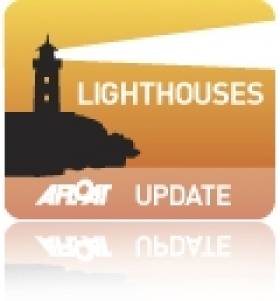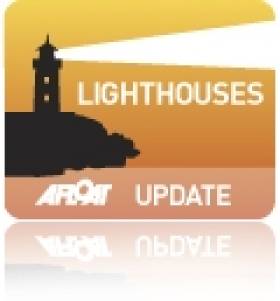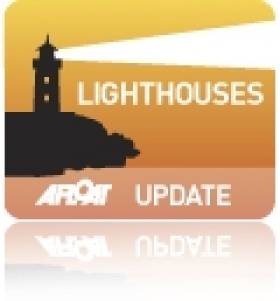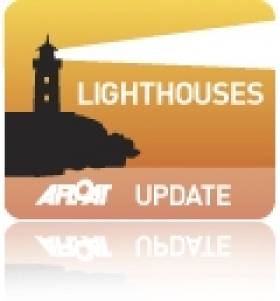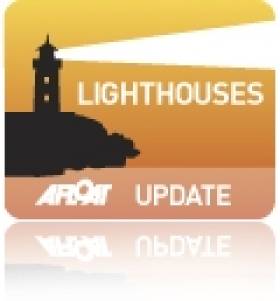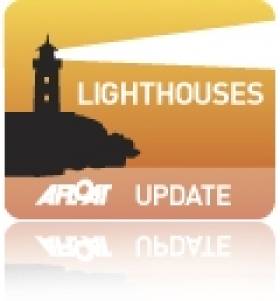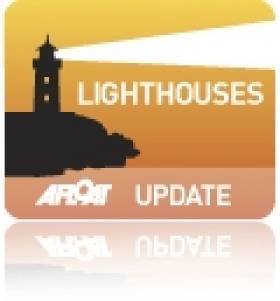Displaying items by tag: lighthouses
Irish Lights Tender Departs Cork Following Dry Docking Sea-Trials
#DryDocking - ILV Granuaile (2000/2,625grt) departed Cork Harbour and is bound for Rosslare Harbour this evening having undergone dry-docking, writes Jehan Ashmore.
Among the work carried out on the Commissioners of Irish Lights tender at Cork Dockyard were some service work done on thrusters and re-chroming of crane rams.
The Dutch Damen Group which built the vessel at their Romanian yard in Galati, had also undergone in Cork Dockyard last year a major '15 Special Survey & Dry-Docking'. The Rushbrooke yard fought off stiff competition for the EU tender as part of a €650,000 project to enable continued operation to Lloyds +100A1 Classification.
ILV Granuaile yesterday morning departed a river-berth for sea-trials. This involved the 79m long lighthouse tender pass Cobh to where a pair of UK registered factory trawlers berthed following detention off the Blaskets by the Naval Service.
She then headed beyond Roches Point Lighthouse, marking the entrance to Cork Harbour from where a circuit was made at sea before returning to the dockyard.
The trawlers Wiron 5 and Wiron 6 are 55m in length and have a Dutch crew of 14 each. They were detained for alleged fishery infringements by the OPV L.E. Samuel Beckett (P61) which escorted the vessels to Cobh and then she headed upriver to berth in Cork City quays.
Northern Lights Scottish Star Set South to Homeport of Irish Lights
#PoleStar – Northern Lighthouse Board's aids to navigation tender NLB Pole Star which normally serves in Scottish waters and also has responsibility for the Isle of Man, made a brief call to Dun Laoghaire Harbour over the weekend, writes Jehan Ashmore.
The presence of Pole Star in Irish waters is not unusual as on occasions, operations require the deployment of these specialist ships between the three General Lighthouse Authority (GLA).
The GLA are the Commissioners of Irish Lights, Northern Lighthouse Board and Trinity House which works in English and Walsh waters and those of the Channel Islands.
During Pole Star's overnight Friday-Saturday call to Dun Laoghaire, the harbour is where CIL are headquartered and is also the homeport of ILV Granuaile, which is understood to be at Cork Dockyard.
As Afloat.ie previously reported, she underwent last year a '15 year Special Survey Dry-docking' awarded to the Rushbrooke based facility that beat off stiff competition from other European yards.
At this stage, it is uncertain if the call to Cork (or for layover period?) was directly to do with the deployment of Pole Star. The vessel departed the Dublin Bay harbour yesterday for Belfast Lough and today headed up the Firth of Clyde bound for Greenock.
Pole Star (2000/1,174grt) the smaller of the two NLB vessels, is otherwise an Oban based buoy-laying vessel which can also carry out hydrographic surveys.
Combined, the GLA's have a fleet of six ships in which CIL's ILV Granuaile built also in 2000, was the first in terms of ship design of the lighthouse umbrella organisation to have her working deck positioned aft. i.e. at the back of the ship where buoys are stowed to and from deployment.
At the time of Granuaile's introduction, this far improved design was followed suit by her GLA counterparts. However, Trinity House's THV Patricia, dating from 1982, remains as the sole survivor of the traditional forward located working deck arrangement between the superstructure and bow.
Notably, she is the only tender to accommodate paying-passengers (numbering 12) who can join the vessel as she carries out her routine duties.
First Phase of All-Ireland Lighthouse Trail Planned For Next Summer
#Lighthouses - The Irish Examiner reports on the new All-Ireland Lighthouse Trail that's planned to launch next summer, eventually linking 20 lights across the border.
The initial phase of the project, which was first announced more than a year ago, will see redevelopment of five lighthouses in Antrim, Down and Donegal, including Fanad Head Lighthouse.
And it's envisaged it will complement the Wild Atlantic Way coastal tourism route from Donegal to Cork.
The Commissioners of Irish Lights website has more on the All-Ireland Lighthouse Trail, which will link up 20 of the island of Ireland's more than 70 lights.
Plans are also in motion to provide for accommodation along the route, plus visitor centres to highlight each lighthouse's story and heritage.
Minister Welcomes Arrangements With UK Over Ships’ Light Dues
#Lighthouses - Minister for Transport, Tourism and Sport Paschal Donohoe today announced an agreement with his UK counterpart Minister John Hayes for light dues paid by ships coming into ports in Ireland and the United Kingdom from April 2015.
Light dues fund the aids to navigation – lighthouses, buoys, beacons and radio aids – operated by the Commissioners of Irish Lights (CIL) in Ireland, and by Trinity House and the Northern Lighthouse Board in the UK.
The three lighthouse authorities, their integrated working arrangements and the single operating system for light dues represents a long-standing co-operation between Ireland and the United Kingdom.
A joint Ireland-UK consideration of the light dues system has resulted in an agreement to maintain the single light dues operational area and to improve the collection and enforcement system for light dues.
This will be of particular benefit to the CIL in relation to light dues payable at Irish ports.
“I welcome this agreement, as I believe the single light dues area has worked well over many years, particularly for the shipping sector," said Minister Donohoe. "It also avoids the need to pay light dues separately in Ireland and the UK, which would have imposed additional costs on shipping on Ireland-UK routes.
"To keep this arrangement in place it is of course important that the shipping sector plays its part in paying its liabilities for light dues promptly. The Commissioners of Irish Lights play a vital maritime role in providing aids to navigation from which the shipping sector benefits, and light dues are a key element of CIL’s funding.”
The minister also referred to CIL’s success in implementing its strategic and operational restructuring programme and in reducing its operational costs by more than 30% over five years.
“CIL has shown its ability to operate as an efficient and dynamic organisation. The agreed arrangements will be in place for a trial period up to March 2018, and monitored for their cost-effectiveness and sustainability.
"I can confirm that the Irish light dues rate will remain at €0.60 per net registered tonne for CIL’s upcoming fiscal year from Apr 2015 to Mar 2016.
"As part of my commitment to CIL and to maritime safety, my department will continue to contribute towards CIL’s costs during the trial period up to March 2018.”
Open House Dublin: Tours of Irish Lights Headquarters
#IrishLightsHQ - The striking designed headquarters of the Commissioners of Irish Lights is one of numerous places of interest to visit in this year's Open House Dublin.
The iconic landmark building that integrates seamlessly into its marine environment along the waterfront within Dún Laoghaire Harbour is open on Sunday 19 October, 12.00pm – 5.00pm
In 2008 Scott Tallon Walker Architects completed the building which comprises two main structures - a circular open-plan office building, linked via an elegant glass enclosed bridge, to a rectilinear engineering maintenance facility. The building utilises many innovative technologies to ensure sustainable building design and energy efficiency.
Visitor Information: First-come basis, just turn up and look out for Open House Dublin volunteers. Last entry: 30 minutes prior to closing. Closest Dart/Rail: Dún Laoghaire.
Visit the Open House Dublin website HERE, which is presented by the Irish Architecture Foundation. From 17 to 19 October over 100 tours, events and workshops will invite you to explore the rich architecture of Dublin. Events are completely free, with most available on a first-come basis.
Record Visitor Numbers at Loop Head Lighthouse
#loopheadlight – Visitors to Loop Head Lighthouse increased by 7.5% during the West Clare landmark's 6-month opening period up to yesterday (Sunday, October 5th).
Figures released today by Clare County Council, which manages the facility in conjunction with the Commissioners of Irish Lights (CIL), reveal that a record 20,368 people visited the 19th century lighthouse.
61% of the total visitor figure was represented by Irish visitors, with North America, the United Kingdom (UK) and Germany each accounting for 8% of the overall figure. Italian and French visitors meanwhile, represented just over 5% of the total figure.
Gerard Dollard, Director of Services, Tourism & Community, Clare County Council said visitor numbers at the lighthouse were buoyed by the development of new services at Shannon Airport, favourable weather conditions during September, and the launch of the Wild Atlantic Way.
"Loop Head Lighthouse is now finishing its fourth year of operation as a visitor attraction. During this time, it has become firmly established as one of Clare's most popular visitor attractions," he said.
Mr. Dollard continued: "Visitor numbers in 2014 have been very much helped by the launch of additional services to and from Shannon Airport and the strong start-up promotion of the Wild Atlantic Way. Of particular notice has been the very strong visitor numbers during the month of September which was no doubt helped by the very fine weather but also by large numbers of American visitors."
"In 2014, the Council provided additional toilet facilities at the site and upgraded and improved the car park area. We will now review the season and examine what further improvements and additional visitor experience can be put in place for 2015," he concluded.
Loop Head Lighthouse, located at the mouth of the Shannon Estuary, is steeped in history and rich in maritime heritage with its origins dating back to the 1670s. The existing tower style lighthouse was constructed in 1854 and was operated and maintained by a keeper who lived within the lighthouse compound.
Taoiseach Enda Kenny's grandfather was a keeper at the lighthouse. James John McGinley took up duty at the Lighthouse as Principal Keeper on 16th January 1933. He spent 1 year and 10 months at Loop Head. He was transferred from the station in October 1934. In January 1991, the lighthouse was converted to automatic operation, and today is in the care of an attendant and is also monitored by the CIL. The Lighthouse is today one of the key discovery points along the route of the Wild Atlantic Way.
Former Scottish Lighthouse Tender to Be Converted into Luxury ‘Boatique’ Hotel Close to Last Royal Yacht Britannia
#FloatingHotel - The operators of UK's last royal yacht, Britannia, a major visitor attraction in Leith have acquired Fingal, a former Scottish tender of the Northern Lighthouse Board, which on occasions worked in Irish waters having called to Dun Laoghaire Harbour, writes Jehan Ashmore.
The near £1 million investment of Windsor Castle, the current name of the classically designed ship built in 1963, is to be converted into a 25 bedroom luxury 'boatique' hotel. She will be berthed permanently adjacent to Britannia in Edinburgh's historic port of Leith.
Fingal was the final ship built by Blythswood Shipbuilding Company in Glasgow. The Leith registered vessel spent most of her Northern Lighthouse Board career of 30 years from Oban followed by her last 6 years based in Stromness, Orkney.
On occasions Fingal shared duties between the three General Lighthouse Authority (GLA) that service aids to navigation throughout the waters of the UK and Ireland.
The tenders continue such operations between the three GLA's, they are the Northern Lighthouse Board (responsible for Scotland and the Isle of Man), Trinity House (England, Wales and the Channel Islands) and the Commissioners of Irish Lights for all waters around this island.
It was during a call by Fingal to Dun Laoghaire Harbour in 1994 that also included Trinity House's Mermaid. This was a rare meeting to witness as two GLA tenders not from Irish Lights were working in our waters.
Mermaid since sold currently works as Ocean Observer for Gardline Marine Services. As previously reported they also operate the former Irish Lights tender Granuaile dating from 1970 and renamed Ocean Seeker.
Having boarded the Fingal during that call to Dun Laoghaire, the 1,432 tonnes vessel had wonderful timber decks and wood panelled exteriors belonging to a bygone era.
In 2000 her career ended with NLB selling her to Tamahine Shipping and for many years she remained laid-up in the River Fal, Falmouth. Fortunately, the 239 foot long veteran vessel which is nearly two-thirds of the size of Britannia has been maintained to the highest standards.
Last Friday she arrived into Leith Docks (click PICS to enlarge). During the week she is relocate to a more permanent berth where she is to undergo a 18 month conversion to be completed for opening in Spring 2016.
According to a spokesperson in contact with Afloat.ie, the work is likely to be carried out by a combination of a team of 20 full-time maintenance staff from the Royal Britannia Yacht Trust (operators of the visitor attraction) and that of an interior design firm(s).
Developing a floating hotel adjacent to the Britannia represents natural organic growth for the Trust, which has the requisite management skills in-house, and servicing demand from both day visitors and evening event guests for quality accommodation.
Commenting on the announcement, Britannia's CEO Bob Downie said, 'After many years of searching for the right ship, we are delighted that we have been able to acquire this iconic vessel and look forward to opening Scotland's first boatique hotel. As a youngster growing up in Oban I have very fond memories of seeing the Fingal and I am delighted that the long-term future of another much loved classic vessel has been secured."
When the new 'boatique' opens she will be berthed adjacent to Britannia, which since her launch in 1953 had toured the world during her 44 years career serving as the British royal yacht for Queen Elizabeth II and members of the royal family.
She would sail to the western Scottish isles for the family's annual fortnight summer holiday cruise which would end by berthing at Aberdeen to allow the monarch to travel to her private residence at Balmoral Castle.
After travelling more than 1 million nautical miles, calling at 600 ports in 135 countries, Britannia was decommissioned in 1997. Her ship's bell as previously reported is on display in Trinity House, London, the headquarters of the English lighthouse authority which celebrates its 500th anniversary this year.
Britannia is officially Scotland's best visitor attraction for the last nine years and the UK's No.1 attraction by TripAdvisor for 2014. Annually she attracts 300,000 visitors. She is renowned for delivering the highest quality of customer experience and the addition of the hotel ship will fit neatly within the overall brand.
#lighthouses – Among the events celebrating the 500th anniversary of Trinity House this year which included the launch of a commemorative photographic book as previously reported, an 'Open Day' is to be held on 20 September at their headquarters in London, writes Jehan Ashmore.
The origins of Trinity House date to 1514 when Henry VIII granted the Corporation of Trinity House a royal charter establishing it as an authority in maritime matters within his kingdom. Later its remit was expanded to include responsibility for the provision and maintenance of aids to navigation within the waters of England, Wales and the Channel Islands.
On occasions, lighthouse tenders share duties by relieving other vessels working for the three General Lighthouse Authorities (GLA). Asides Trinity House the GLA is also made up by the Northern Lighthouse Board, responsible for Scottish and Isle of Man waters. Our Commissioners of Irish Lights whose remit covers all aids to navigation around the island of Ireland.
In May an official ceremony to mark the quincentenary of the Corporation of Trinity House took place at Trinity House located on Tower Hill overlooking the historic Tower of London. On that occasion another Open Day was held for members of the public to view the house built in 1794.
The House has a wealth of historic and valuable paintings plus antiques, bears out the UK's remarkable nautical heritage. One of its more recent acquisitions is the brass bell from the Royal Yacht Britannia which was decommissioned in 1997 and remains open to public tours in Leith, the port for Edinburgh.
On the next Open Day, there is no need to contact Trinity House, as interested day-visitors can simply arrive and wander about the House at their leisure and information available from expert guides. Visiting hours are confined only to that date (Saturday 20 Sept) between 10am – 3pm.
Otherwise tours of Trinity House are organised (but charged at a fee) on selected dates in 2015. Booking is essential and can be done by calling 00 44 (0)20 7481 6900 or emailing: [email protected] For futher information, click HERE.
Commissioners of Irish Lights Chart First Permanent Virtual Aid to Navigation in Irish Waters
#lighthouses – The Commissioners of Irish Lights (CIL) has the first permanent Virtual Aid to Navigation charted in Irish Waters on the 5th June 2014. The port hand Virtual Aid to Navigation was established at the entrance to Belfast Lough on the North East Coast of Ireland. This was in response to a newly reported shoal depth of 8.0 metres at the Rigg Bank.
CIL explored various options to ensure the shoal depth was addressed correctly. One option was to place a buoy to mark the pinnacle depth. However, after completing a Risk Assessment and extensive Automatic Identification System (AIS) analysis, it was clear the buoy would introduce a new danger in the relatively deep water. As a result, the port hand Virtual Aid to Navigation was chosen and deployed approximately half a nautical mile east of the position of the new pinnacle depth on the 20th November 2013.
Deirdre Lane, Navigation Policy Officer in CIL commented "It was found that deep draft vessels which need to have the pinnacle depth highlighted the most, are those that have the capability for a Virtual Aid to Navigation to be displayed on their on-board systems. In this unique set of circumstances, it was clear the Virtual Aid to Navigation was the best option".
One of the functionalities of AIS is that a land based AIS station can be used to transmit the position of an AIS Aid to Navigation that does not physically exist in the water. It is represented as a digital symbol on the ships Radar, Electronic Display and Information System (ECDIS) or Integrated Navigation System.
In order to bring the Virtual Aid to Navigation to the Mariners attention, it was officially mapped on navigational charts by the UKHO at CIL's request on 5th June 2014. As a result, CIL is responsible for the first permanent charted Virtual AIS Aid to Navigation in Irish waters.
#Lighthouses - Check out this amazing video (care of the Irish Coast Guard's Facebook page) of daredevil lighthouse keepers changing shift off the coast of France.
With the rough seas far too choppy for boats to move in close to the rocky island beneath the lighthouse, the only option is to zip back and forth via a rope thrown from the tower secured to the vessel.
That's one job that's definitely not for the faint-hearted!


























